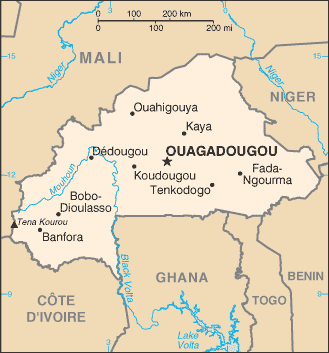Map:

Overview:
Burkina Faso (formerly Upper Volta) achieved independence from France in 1960. Repeated military coups during the 1970s and 1980s were followed by multiparty elections in the early 1990s. Burkina Faso's high population density and limited natural resources result in poor economic prospects for the majority of its citizens. Recent unrest in Cote d'Ivoire and northern Ghana has hindered the ability of several hundred thousand seasonal Burkinabe farm workers to find employment in neighboring countries.
The People:
Population: 13,925,313
note: estimates for this country explicitly take into account the effects of excess mortality due to AIDS; this can result in lower life expectancy, higher infant mortality and death rates, lower population and growth rates, and changes in the distribution of population by age and sex than would otherwise be expected (July 2005 est.)
Age structure:
0-14 years: 46% (male 3,213,436/female 3,193,253)
15-64 years: 51.2% (male 3,487,201/female 3,635,673)
65 years and over: 2.8% (male 164,418/female 231,332) (2005 est.)
Religions:
indigenous beliefs 40%, Muslim 50%, Christian (mainly Roman Catholic) 10%
Government Type:
parliamentary republic
Leader(s) to pray for:
chief of state: President Blaise COMPAORE (since 15 October 1987)
head of government: Prime Minister Ernest Paramanga YONLI (since 6 November 2000)
Source: The World Factbook
View All Countries